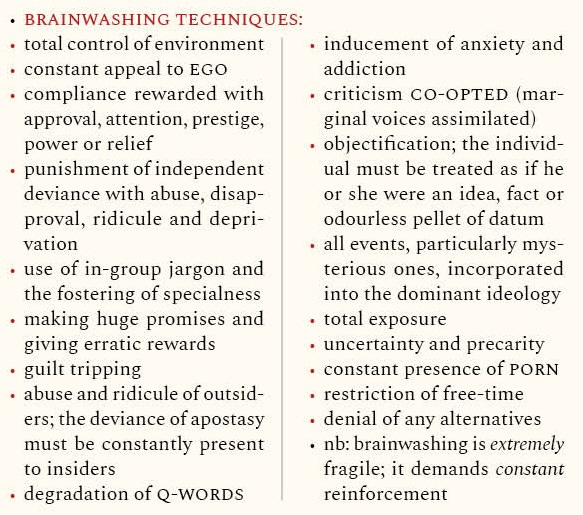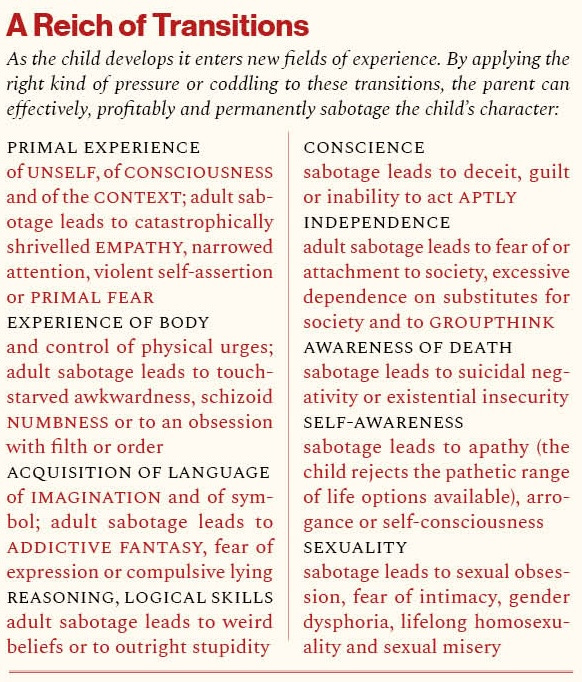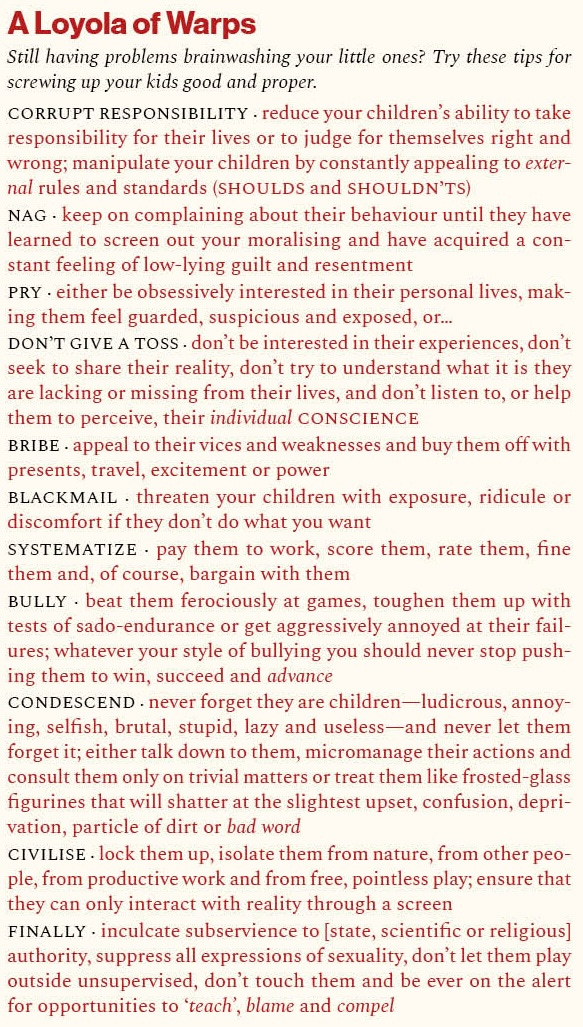The selves of the very young are so soft that they do not just ‘experience’ what is happening, they are what is happening. There is no separate ‘me’ witnessing ‘not me’. For the very young the sounds, smells, sights and, most intensely, the hyper-subtle atmosphere of the room (a.k.a. the context) are indistinguishable from the child’s default inner state of soft-consciousness, which she shares with the selfless adult, or the selfless hedgehog, in selfless communion.
Needless to say, such a mode of experience is acutely subversive and must be obliterated. Children who are allowed to grow up in continual contact with inner ease grow into adults who do not need external stimulus to feel content, or to bolster their sense of self-worth. They are poor consumers, poor workers, unprofitably sensitive to conscience and reluctant to compromise. They are, in short, a threat.
To neutralise this threat you must cut your child off from its own felt reality, and replace her soft, context-integrated self with a hard, isolated ego. There are three interconnected ways to achieve this; a) hard-focus: forcing the wide sensory attention of the child out of the whole present moment and into divided-up parts of it b) emotion: gripping your child’s attention with the wants (pleasures) and not-wants (sufferings) of the self c) sabotage of transitions: stunting your child’s capacity to exit their newly acquired needy-anxious self-realm and enter genuinely new, non-egoic, experience.
a. Hard Focus
The ultimate purpose of brainwashing is to replace direct experience with a mental–emotional image or representation of reality (provided by external authority), but this cannot be done without first dividing your child’s experience up into bits. Ordinarily, this ability to split reality up—and then to create ideas based on the divisions—happens naturally; leading to language, imagination and a sane relationship with the shared waking world. Your job though is to force nature, so that your child is always focused on isolated things (subjects and objects). The constant discomfort of this unnatural over-focus will corrupt her blended sensitivity to what is really going on and replace the context with a tense, irritable emotionality upon which you can build all your subsequent manipulations.
The key here is to take your child out of its body. It must be constantly, miserably, wanting things; and the first thing it naturally wants, is you, so don’t, whatever you do, carry your baby around (or sleep with it) allowing it to feel the reassuring warmth and security of your presence. Ignore all natural instincts. Strap your child into a pram or pushchair, or imprison it in a cot. This will rapidly habituate your baby to a hostile world of lonely captivity, which is a prerequisite for compelling it to flee into representation. If you cannot bear its screams of misery, there are plenty of excellent baby-brainwashing devices to help you stupefy your infant into a tense, hypnotic trance state. Repetitive digital sound-effects work well, as do light-emitting diodes. If these are not around, jiggle the poor creature up and down and make calming ‘shh-shh’ noises. This will briefly pacify their horror at being abandoned and emotionally stupefy them into a submissive acceptance of an alien, inhospitable, uncaring universe.
As early as possible get your kids watching a screen all day, playing computer games, watching cartoons or, if possible, plugging them into a VR headset. Loud rapidly changing CGI scenes of sanitised fantasy smattered with a patina of formal morality work best. The primary purpose here is to instil worry and anxiety through speeding up the psyche of the child, digitising its consciousness and beaming a stream of things to ardently want through its tiny, concentrated fovea. The secondary purpose is to get your child used to the idea that dreams only come true on the video screen, and that reality isn’t really real; it’s a kind of show, which you are supposed to passively like or not like, want or not want—never consciously experience or actively contribute to.
When your child is old enough to understand the wonderful word ‘should’, you must moralise to her. The key here is to have the greatest disparity possible between what you say and what you do (or the way you say it) by constantly going on about what is right and wrong without ever taking action, by imposing arbitrary discipline and by living in a manner which makes a mockery of your imposed laws. If your little boy’s heart is being crushed by the screen, feel terribly upset about it, by all means, but don’t give up your screen! If your little girl disturbs you with her spontaneous physicality, freeze, purse your lips, give her an awkward little pat and say, with great emphasis, ‘of course Mummy loves you’. If your child is lazy, bored and without initiative then tell her to get off her arse and do something; don’t, whatever you do, show her, with your own life, that adults do not require compulsion to do anything and don’t, for God’s sake, actually lead a meaningful life of free, creative activity yourself, or she’ll see how to live her life.
Having a gulf between what you say and how you live drives a schasm through a child’s psyche; while implicitly programming her with the most important moral lesson of all—that truth does not really exist; only ideas, words, facts and no end of taboos, totems, laws, legitimations and egoic rituals. It is then easy to addict your child to the primary substitute for free, natural, embodied truth; abstract power, the means by which your child can assimilate itself into the system and unthinkingly submit itself to authority, while taking out its repressed resentment for having to do so on scapegoats.
b. Emotion
It’s not enough just to create for your child a reality comprised entirely of atomised objects, isolated experiences and words. You must also make him ardently want or not want them. This background emotionality is the fuel that drives your child into his egoic self and the means by which he can be threatened, purchased and manipulated.
The first step in creating such constant emotionality is, first of all, to not understand it. You should have no idea of the difference between crude, coercive emotion and subtle polychromatic feeling, so your trivial annoyances, moodies, depressions, dullness of spirit and so on feel normal or, at least, excusable. Then, you should make sure that, as far as possible, you are continually emotional; restlessly bored, annoyed, depressed, anxious, excited or, covering this brittle warzone, coldly suppressed.
In this way, you will fill the house with suffering. It won’t seem so dramatic to you, but while you are feeling harried, bored, irritable or under par, your baby, forty-thousand times more sensitive than you, will be experiencing these ordinary moodies as knives of violence or horrorful separation which will cause him to become emotional in turn; wanting and not-wanting. He won’t necessarily know what he wants; he will just be wanty; an intense (tense) state of in-self.
As your child grows he will learn to use his developing self not merely as a tool for thinking and playing, but as a defensive weapon; conniving for stimulants—such as sugar and adrenaline—and for proto-narcotic hits of attention, acquisition and hypnotic virtuality; which you should be sure to periodically lavish on your kids—pumping them up beforehand with ‘ooh-it’s-your-birthday-soon’ type excitement—in order to habituate them to the cycle of boredom, agitation, wanting, expectation, fear-of-not-getting, over-excitement-at-having, disappointment and return to base-boredom which makes the world go round.
The final and most direct component of emotionalising your child is through periodically exciting his fears and desires. This doesn’t just consist in terrifying your little boy with visions of hell, pushing him into confusing and uncomfortable situations (such as school), or dangling fantastic imaginary delights in front of his mind’s eye—although these are all excellent ideas—but in continually appealing to his likes and dislikes. These are not mere preferences—the usual configuration of inclination and taste that makes one child different from another—but a kind of rudimentary religion of me; a means of converting the child’s ungovernable inner-reality into a tractable collection of fetishised labels which, in times of uncertainty, your child will, in lieu of genuine character, cling to. This must go hand in hand with an obsessive over-concern with the specialness of your little one and a lifelong project of protecting him from the wisdom of pain.
c. Sabotage of Transitions
As your child grows, you should be alert to when she first enters a new sphere of experience—or transition—into the unknown (or unself). By correctly applying violence, pressure, disinterest or fretting, hovering anxiety you can warp your child away from selfless reality, forcing her into a cycle of repeated psychological crises that will play out for the rest of her adult life.
One of the best ways to sabotage transitions—alongside ordinary restlessness, stress and disinterest—is to make your affectionate attention, or ‘love’ conditional. When your child conforms to your expectations or acts in a way you approve of, reward her, and when she does something you don’t like, punish her; again, not physically or verbally (although that will certainly help), but viscerally; through emotion, tone of voice and imperceptible micro-expressions; none of which you will be aware of, but all of which will reinforce the self of your child and teach her that a) certain kinds of freedom are strange, wrong or shameful and b) we cannot ever really admit this to anyone.
After five years of home brainwashing, your child should be sufficiently anxious, unempathic, demanding, bossy, snobby, repressed, self-assertive, bland, stiff, digitised, clumsy, fundamentally confused by life or afraid of the unknown to leave the nest and make her way through the world of the school and system.
If not, don’t worry; she soon will be!
How to Brainwash the World…
You have been reading part one of a three-part series—including How to Indoctrinate Your Students and How to Institutionalise the World—all of which you can find in the second most subversive book on earth, The Apocalypedia.
You can read some more extracts here:








